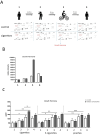Influence of Different Nicotine Sources on Exercise-Driven Immune Responses of Peripheral Blood Monocytes
- PMID: 40559945
- PMCID: PMC12197595
- DOI: 10.3390/toxics13060472
Influence of Different Nicotine Sources on Exercise-Driven Immune Responses of Peripheral Blood Monocytes
Abstract
Tobacco smoking is closely associated with pro-inflammatory immunological alterations, whereas regular physical exercise is well known to lower systemic inflammations and related immune cell activities. The combined effects of smoking, nicotine pouch use, vaping, and exercise on individual immunological responses remain incompletely understood, especially in view of alternative nicotine delivery systems. In this study, we analyzed the immediate impact of different nicotine sources on exercise monocyte subsets in 16 human subjects using a four-arm cross-over design. Distribution of circulating CD14/CD16 monocyte subsets and expression of the monocytic checkpoint molecule PD-L1 (programmed cell death ligand-1) were analysed via whole blood flow cytometry measurements. Plasma cytokines were evaluated using membrane-based cytokine arrays and enzyme-linked immunosorbent assays (ELISA). Data revealed significant distributions of circulating monocytes subsets in response to nicotine consumption and physical stress. In contrast, exercise-driven increased monocytic PD-L1 was clearly attenuated following the consumption various nicotine delivery systems. Furthermore, significantly increased plasma growth hormone levels were detected in response to physical stress in combination with cigarette consumption. Our data clearly illustrates a significant influence of nicotine consumption on the cellular characteristics of circulating monocyte subsets and on proper exercise-driven immune responses within a short period of time, which makes the widespread trivialization of alternative nicotine sources questionable.
Keywords: PD-L1; exercise; growth hormone; monocytes; smoking.
Conflict of interest statement
The authors declare no conflicts of interest.
Figures





Similar articles
-
Interventions to reduce harm from continued tobacco use.Cochrane Database Syst Rev. 2016 Oct 13;10(10):CD005231. doi: 10.1002/14651858.CD005231.pub3. Cochrane Database Syst Rev. 2016. PMID: 27734465 Free PMC article.
-
Smoking cessation medicines and e-cigarettes: a systematic review, network meta-analysis and cost-effectiveness analysis.Health Technol Assess. 2021 Oct;25(59):1-224. doi: 10.3310/hta25590. Health Technol Assess. 2021. PMID: 34668482
-
Electronic cigarettes for smoking cessation.Cochrane Database Syst Rev. 2022 Nov 17;11(11):CD010216. doi: 10.1002/14651858.CD010216.pub7. Cochrane Database Syst Rev. 2022. Update in: Cochrane Database Syst Rev. 2024 Jan 8;1:CD010216. doi: 10.1002/14651858.CD010216.pub8. PMID: 36384212 Free PMC article. Updated.
-
Electronic cigarettes for smoking cessation.Cochrane Database Syst Rev. 2021 Sep 14;9(9):CD010216. doi: 10.1002/14651858.CD010216.pub6. Cochrane Database Syst Rev. 2021. Update in: Cochrane Database Syst Rev. 2022 Nov 17;11:CD010216. doi: 10.1002/14651858.CD010216.pub7. PMID: 34519354 Free PMC article. Updated.
-
Pharmacological and electronic cigarette interventions for smoking cessation in adults: component network meta-analyses.Cochrane Database Syst Rev. 2023 Sep 12;9(9):CD015226. doi: 10.1002/14651858.CD015226.pub2. Cochrane Database Syst Rev. 2023. PMID: 37696529 Free PMC article.
References
LinkOut - more resources
Full Text Sources
Research Materials

